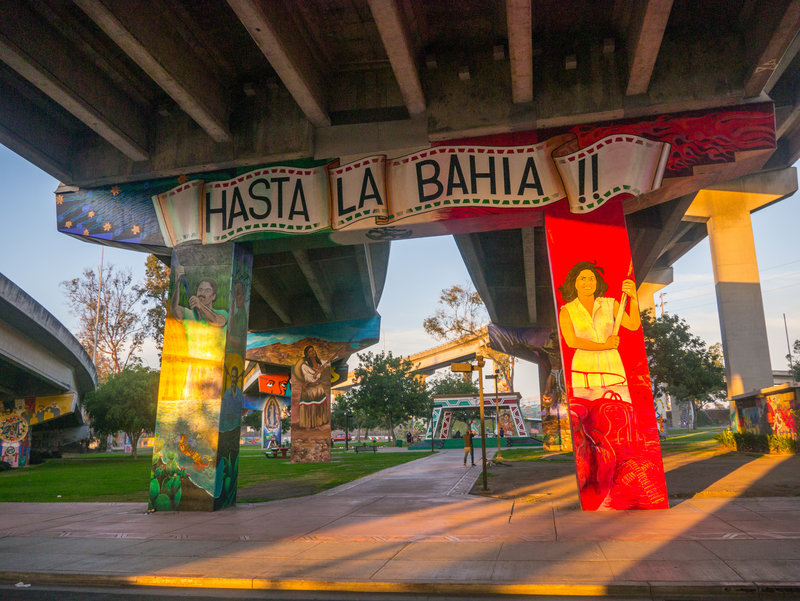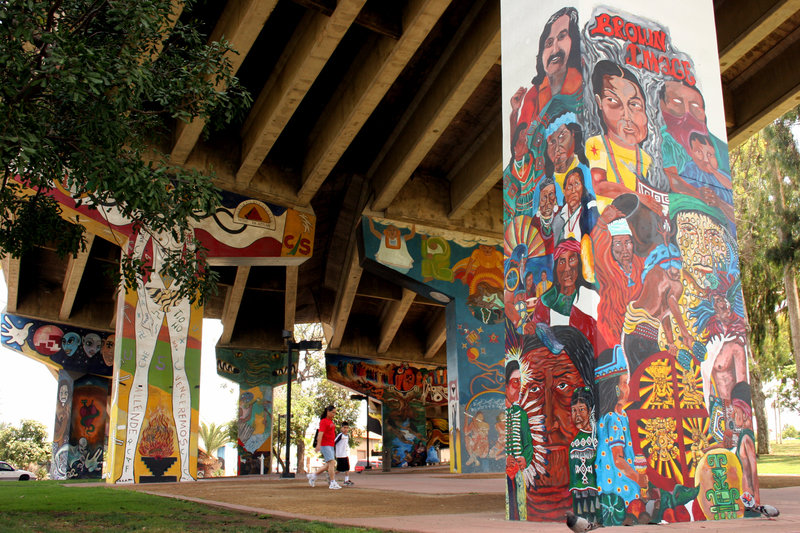While public space is inherently meant for everyone, it’s rarely designed by those who will use it the most. Traditional urban planning practices oftentimes promote gentrification, and fail to reflect BIPOC voices and experiences. The outcome is that public spaces fail to represent all citizens at best, and make minorities feel excluded or unsafe at worst. BIPOC communities across the United States offer a compelling template for equitable placemaking. In El Paso, Phoenix, and Santa Barbara, Chicano art enlivens bare underpasses and utilitarian spaces with murals. In other cities like LA, Latino communities have brought life to their neighborhoods through ‘Latino urbanism’, a term coined by urbanist James Rojas, with features like tienditas (small, independent corner stores), plazas, murals, and rasquache art. (‘Rasquache’ was widely used as a classist slur meaning ‘lower class’ or ‘in bad taste’, but has been reclaimed by communities to describe the aesthetics of Chicano art and Mexican art.)
Chicano Park in San Diego is another great example of BIPOC communities reclaiming public space. Located in the heart of Barrio Logan, Chicano Park is home to over 100 murals across seven acres in the underpass area of the Coronado Bay Bridge. The park is also home to sculptures, gardens, picnic tables, performance spaces, and playgrounds. The development of Chicano Park was a response to traumatic gentrification and was fueled by the Chicano Movimiento, which brought Chicanos together for years with the purpose of combating structural racism and advocating for social and political empowerment by embracing the Chicano identity and rejecting assimilation.
In the 60s, the California Department of Transportation (Caltrans) built a freeway through Barrio Logan, demolishing homes and splitting the neighborhood in two. To compensate, residents were promised a park that was only completed after vigorous community rallying and negotiation that lasted for over a decade. Since 1971, local artists and artists from across California have been invited to showcase their art and messages of Chicano pride and self-determination in the park, using the bridge’s massive pylons as canvasses.
“When you work out of love for your people, all things are possible. A community came together in our case and did the impossible,” said Lucas Cruz, Chairman of the Chicano Park Steering Committee, which historically led the charge to reclaim Chicano Park, and which continues to advocate for the community. Sharing what he thinks other communities can learn from them, he continued, “We all have to look at our abandoned spaces in our communities. We don’t need to go to the oppressors and ask for support. We just have to roll up our sleeves and do the work ourselves.” Cruz suggests this should emerge as a form of empowerment and ownership of community spaces rather than be borne out of resignation or even resentment for the harms caused by gentrification.
Resources for landscape maintenance and upkeep of the park and murals either come from community fundraising—through the sale of art, t-shirts, pozoles, and more—or from the artists themselves; whenever there is damage to the murals, the artists come and fix it with their own materials, asking nothing in return. On only two occasions has the Chicano Park Steering Committee received funding from the State for restoration. This level of self-dependency is a result of a fundamentally flawed system, where commercial considerations and rapid development have resulted in the neglect of communities, usually minorities, who have had to pay the price of being pushed out of their neighborhoods, enduring underinvestment and broken promises. The silver lining, in the case of Barrio Logan and the Chicano Park Steering Committee, is that they have enjoyed a degree of control over what happens in the park.
Progress has been made in the relationship between the neighborhood, CalTrans and the city, mainly due to individuals who have taken the time to get to know the community, collaborate with them in an intentional way, and to provide resources to elevate the work they’re already doing.

As for what city officials and urban planners could learn from Chicago Park, Cruz had this advice:
- City governments and urban planners are used to outsourcing community engagement through nonprofits or other entities, but they need to come out and listen to the people themselves—both for relationship building purposes and to actually know what people’s priorities are.
- The moment there is the intention to do a project, outreach should start then and there. Going to communities with specific options and asking them to choose from that list is not real community engagement. If you want input, you need to consult people from the beginning and design the options with them. If the answer is “no” or “not yet,” that is the answer.
- You need to meet people where they are—literally. Social media is not enough; you have to actually knock on people’s doors in some cases if you want to reach meaningful consensus.
Cruz points out that it used to be much easier for people to rally around a shared cause, but over time, there has been a disconnect that has made it challenging to achieve unity—something we clearly see across a variety of contemporary issues. Trust is hard to build or rebuild even between community members and leaders, let alone the community and outside institutions. He points out that we cannot live off legacies, so there is a constant responsibility towards investing in and renewing relationships with communities.
What would it mean for cities to center communities of color in the activation of public space?
Embedding equity in public space takes commitment, resources, and trust. It begins with acknowledging and celebrating the ways in which communities of color have already been leading the way. If we position ourselves as advocates, and we continue to place our resources strategically in the right hands to encourage organic growth, we will be able to create spaces that are not only impactful for newcomers, but also representative and true to the essence of the local community. Long-lasting impact requires ownership and buy-in from those that will benefit from the space and ultimately activate it.
As we approach our work on new and existing public spaces, let us not only think about who we want to serve and how, but also about taking the additional steps to consult with voices from within the relevant neighborhoods. Bring those voices to the table, not only as unpaid advisory committee members or for “community engagement”, but as stakeholders and decision-makers through every step of the process. The ultimate goal should be for community members to be stewards of the spaces in their neighborhoods and to see their cities as blank canvases for creative expression — backed by resources and support from the same power structures that caused harm in the first place.
BIPOC-led placemaking emerged as a form of resistance to racism and gentrification. But it is on all of us to acknowledge how much we owe to the communities of artists, activists, and residents who have not only beautified our cities, but also shown us that public space can and should be for everyone.

